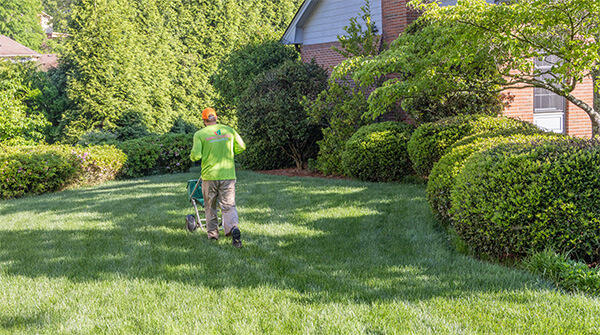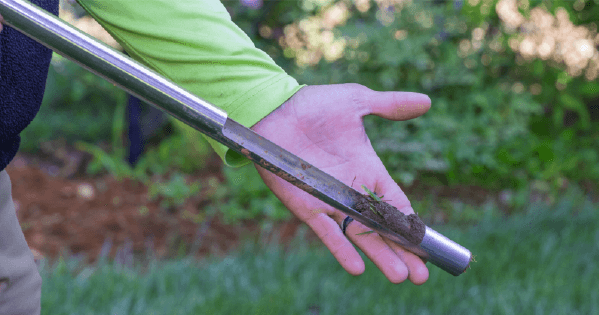What Is Fescue Aeration and Seeding?

Fescue aeration and seeding is the process of repairing your lawn and preparing it for the next growing season. The stress of Georgia’s hot summers coupled with high disease pressure leaves fescue lawns struggling by summer’s end.
Core aeration will help to reduce compaction by mechanically removing cores of soil allowing water, nutrients, and oxygen to reach the root zone of your grass more readily. In addition, core aeration creates an ideal environment for new seeds to establish.
Seeding replenishes thin and bare areas of your lawn and with new seed growth, you have a thicker lawn that is better suited to crowd out weeds. Best of all, a thicker lawn will provide you with an aesthetically pleasing property.
Fescue Seeding Benefits
Seeding your fescue lawn in late summer significantly improves its overall density and visual appeal. Over time, lawns can become sparse due to natural wear, foot traffic, and environmental factors. Seeding introduces new grass plants, filling gaps and creating a thicker, more luxurious carpet of grass. This enhanced density contributes to a lush, vibrant lawn that becomes the envy of the neighborhood.
Filling in Bare Patches and Thin Areas: Bare patches and thin areas are common issues in many lawns, often resulting from factors like disease, insect damage, or unfavorable growing conditions. Seeding helps address these problems by establishing new grass growth in areas where the turf is weak or nonexistent.
Increased Resistance to Pests and Diseases: Seeding introduces fresh grass plants that are more resilient and better able to withstand potential threats. The newly established grass can outcompete weeds, reducing the space available for invasive plants and pests to take hold.
Contributing to Overall Lawn Health and Longevity: Introducing new seed, enhances the lawn’s ability to adapt to changing environmental conditions and challenges. A robust, well-established lawn is better equipped to recover from stress.

Fescue Aeration Benefits
Lawn aeration is a fundamental practice in turf care that involves perforating the soil with small holes to alleviate issues related to soil compaction and poor air circulation.
Aeration creates channels for air, water, and nutrients to penetrate deeper into the soil, promoting optimal root development and enhancing the overall vitality of the lawn. Other benefits of aeration include:
1. Enhanced Nutrient Absorption: Aeration facilitates better nutrient absorption by creating pathways for them to reach the root zone. This results in improved nutrient uptake, leading to stronger and more vibrant fescue growth.
2. Stimulated Root Growth: The holes created during aeration encourage root expansion and deeper penetration into the soil. Deep roots are more efficient in accessing moisture and nutrients, contributing to greater drought tolerance and overall plant health.
3. Improved Oxygen Exchange: Aeration increases oxygen exchange between the soil and the atmosphere. This oxygen-rich environment is conducive to beneficial soil microorganisms, which contribute to nutrient cycling and the breakdown of organic matter.
4. Water Infiltration and Drainage: Aeration alleviates soil compaction, allowing water to infiltrate the soil more effectively. This reduces the risk of surface runoff and waterlogging, creating a balanced and well-drained root zone.
5. Reduced Thatch Accumulation: Thatch, a layer of dead grass and organic matter, can accumulate on the soil surface and hinder water and nutrient movement. Aeration helps break down thatch and accelerate its decomposition, contributing to a healthier soil structure.
FAQs for Aeration and Seeding Preparation
If you would like to get your fescue lawn aerated and seeded, it's important that you review these FAQs and implement our recommendations before the service date.
What should I do if I have an irrigation system?
If you have an irrigation system, you are required to mark all irrigation heads located in the turf grass areas. To mark your irrigation, place a stick, a plastic knife/fork, or a flag next to each irrigation head located in the lawn.
What if I have an invisible dog fence?
Like irrigation systems, it's required that you mark the location of the fence by placing sticks, plastic knives/forks, or flags along the perimeter of the invisible fence.
*In addition to marking your irrigation heads and invisible dog fence, we highly recommend calling 811 to mark your utility and communication cables.
Do I need to water my grass before the aeration?
Yes, core aeration will require your lawn to be watered before our arrival. In the absence of rain, water your lawn the 3 days leading up to your scheduled aeration. Be sure to give your lawn 1-2 inches of water at each watering.
**Note: The quality of plugs will depend on the moisture content of your soil.
Should the grass be mowed before the aeration and seeding?
Yes, your lawn must be mowed with a height of 2 inches or lower, prior the aeration and seeding. Grass clippings and any debris must also be removed from your lawn prior to the service.
Post-Seeding Care Guidelines
The success of the seeding and aeration process as well as the overall beauty of your lawn will rely on how well you care for it during the weeks after the service. Below are guidelines for how you should care for your lawn after the aeration and seeding:
Water Recommendations for Weeks 1-3 After Seeding
Daily watering is required for the first 2-3 weeks after the seeding. Give your lawn ¼ inch of water per day. With proper watering, your seeds should start germinating within 10 days after the seeding.
**Note: Insufficient watering is the most common cause of seed germination failure. It's critical that you do not allow the seedlings to dry out. The seeds must be kept moist at all times.
Water Recommendations for Weeks 4-9 After SeedingAfter weeks 2-3, your seeds should be fully germinated. These new seedlings will need to be kept moist for 4-6 more weeks, so their roots and blades can develop properly.
Mowing Your Lawn After SeedingIt’s recommended to wait until the new seedlings are at least 3" in height before mowing your lawn. If the lawn is mowed too soon, it can damage the new grass.
**Note: We recommend you sharpen your mower blades and set the mow height to 3.5" before mowing.
Contact our team today in Atlanta to learn more about our fescue lawn aeration and seeding services and to schedule a consultation. We look forward to helping you achieve the beautiful, healthy lawn you've always wanted!

